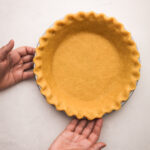Olive Oil Pie Crust
This Olive Oil Pie Crust recipe is perfect for savory pies and so easy to make. The best part is that you don't need to chill it, so it's a great option for easy weeknight dinner pies. It also happens to be dairy free!
- Prep Time: 00:08
- Cook Time: 00:00
- Total Time: 8 minutes
- Yield: 1 pie crust
- Category: Pie Crust
- Cuisine: Italian
Ingredients
- 1-3/4 cups (210 grams) all-purpose flour, plus extra for work surface
- 2 teaspoons granulated sugar
- 1-1/2 teaspoons baking powder
- 1 teaspoon (3 grams) coarse kosher salt (see note)
- ⅓ cup (70 grams) olive oil
- 2 large eggs
- 1 egg yolk
Instructions
- In a medium bowl, use a fork to stir together the flour, sugar, baking powder, and salt.
- Make a well in the center of the dry ingredients and add in the oil, eggs, and yolk. Use the fork to beat the eggs and oil together until they are combined. Then, gradually draw the dry ingredients into the egg mixture until the flour is almost all hydrated.
- Briefly knead the dough together just until it is mostly smooth, about 3-4 times. Do not over knead it or the oil will start to separate out from the dough.
- Wrap the dough in plastic wrap and let it sit at room temperature for a minimum of 10 minutes and maximum of 30 minutes (see note) so the dough can rest and fully hydrate.
- When ready to roll out, liberally flour a work surface.
- Use a rolling pin to roll out the dough, making sure it isn’t sticking to the surface. Transfer to the desired pan and bake with your recipe of choice. This dough is best baked in a 375ºF oven. See this post’s article for more notes about baking with this dough.
Notes
This recipe is adapted from pastry chef and cookbook author Nick Malgieri.
Weighing your flour is the most accurate way to measure, especially with this recipe. If you aren't going to weigh it, make sure to spoon it into the measuring cup, then level it off. If you scoop the flour out with the measuring cup and then level, it could change the outcome of the final product.
This recipe was tested using Diamond Crystal coarse kosher salt. If you use Morton's kosher salt or fine salt, decrease by half for volume.
Let the dough rest at room temperature for 10-30 minutes after you make it. This helps relax the gluten, allows the dough to fully hydrate, and gives the baking powder time to activate, making it easier to roll out the dough later. If you handled the dough correctly (aka you didn't develop excessive gluten), it can be ready to roll in 10 minutes. If the dough springs back and is tricky to roll out, it likely needs a few more minutes to relax the gluten.
Find it online: https://everydaypie.com/olive-oil-pie-dough/
